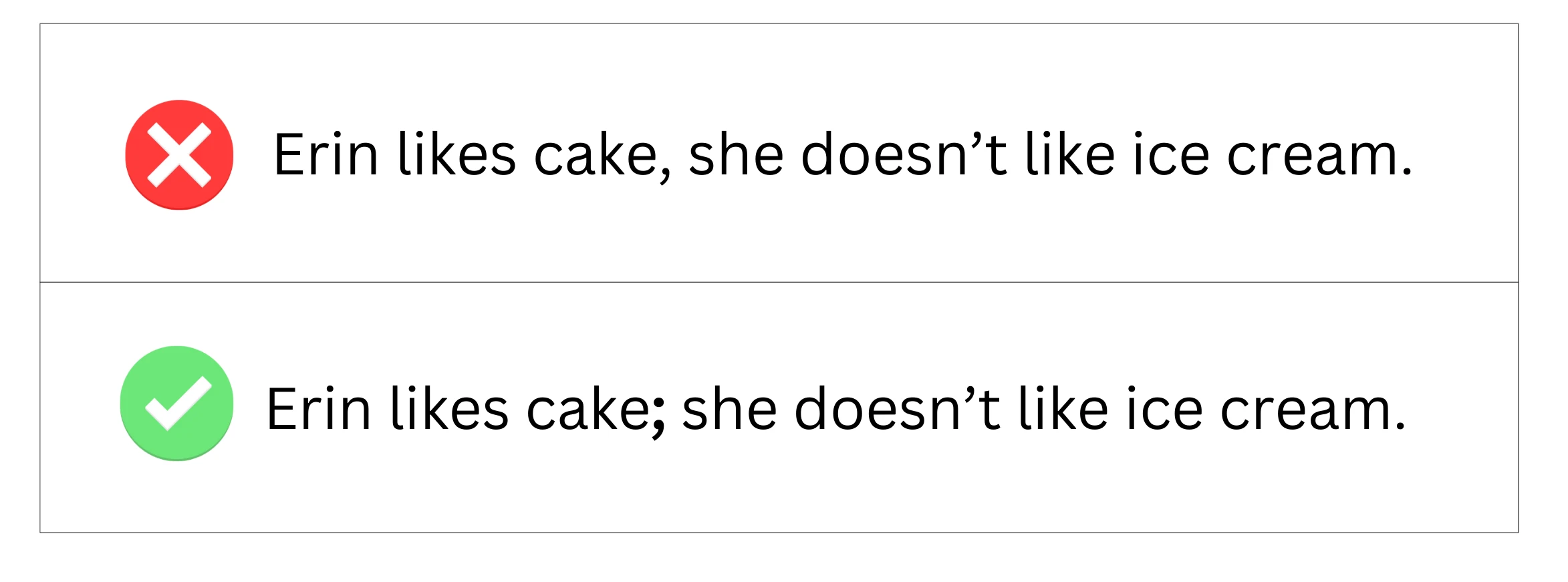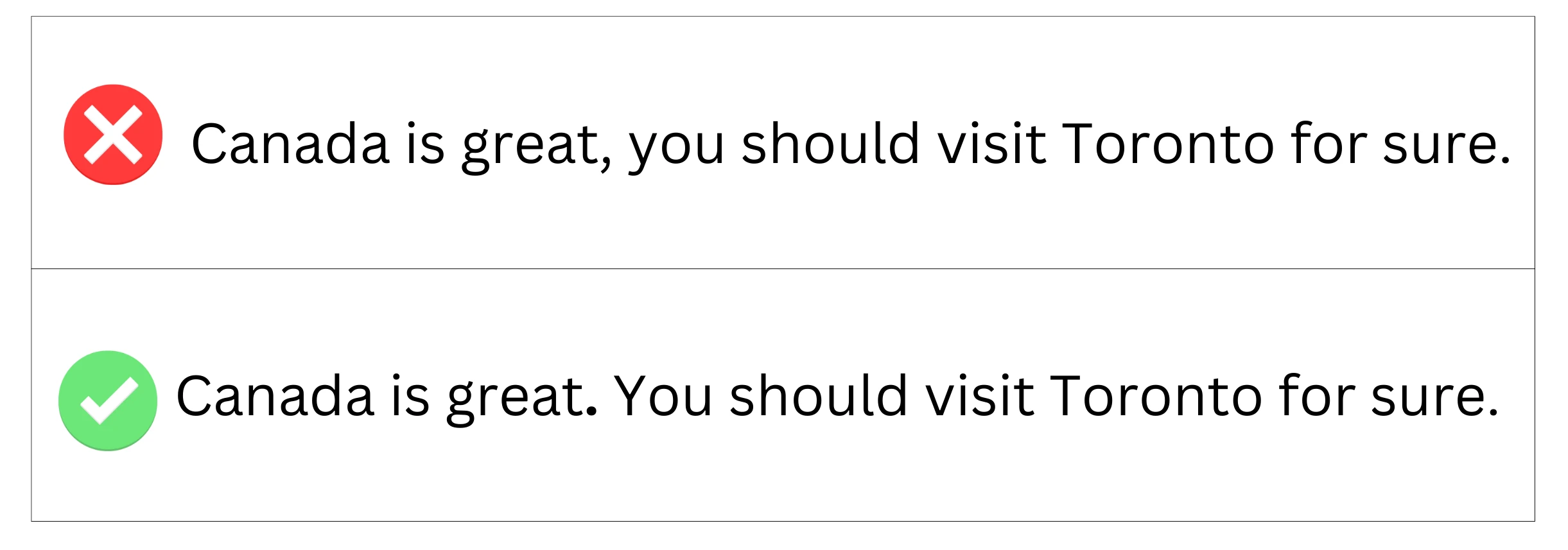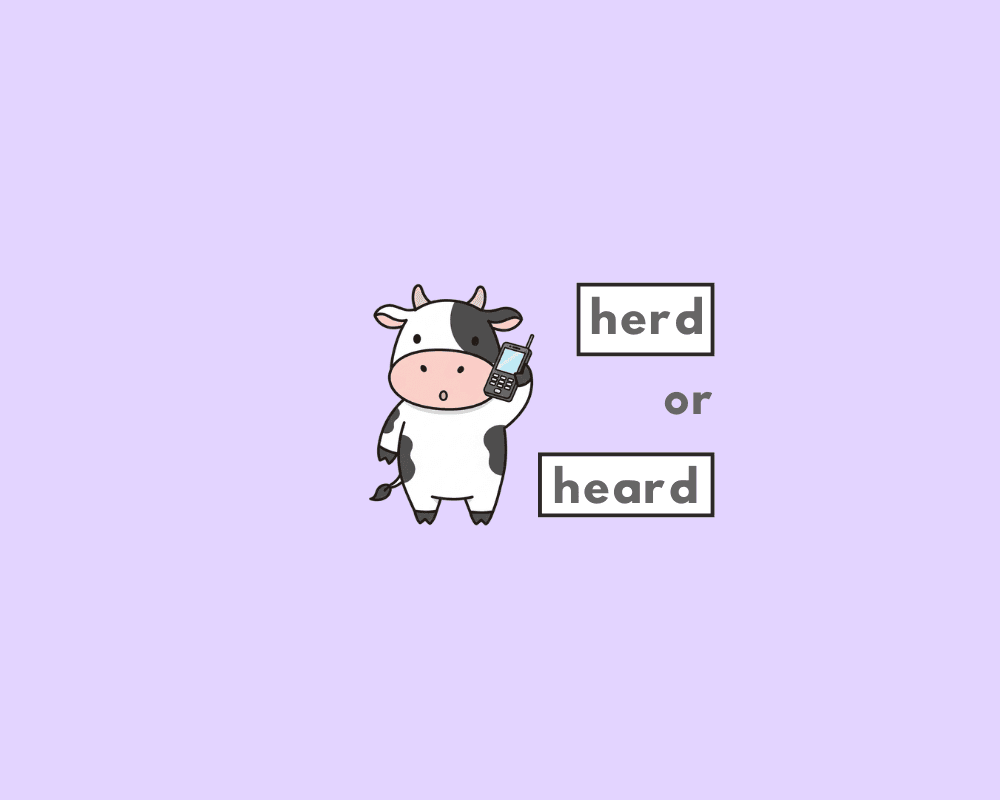What’s a “comma splice”?
A comma splice is when a comma separates two independent clauses without the proper coordinating conjunction or punctuation. Stick with this guide to learn all about comma splices, and how best to avoid them in your writing, (and fix them if they do come up).
The weather was bad, so we stayed inside.
She loves to read; her favorite genre is fantasy.
The dog barked loudly, the cat ran away.
He finished his homework, he went to play video games.
How to spot a comma splice
| Word Form | Examples |
|---|---|
| Other | She wanted to go to the store, he preferred to stay home.
She wanted to go to the store. He preferred to stay home. She wanted to go to the store, he preferred to stay home. (incorrect) She wanted to go to the store, but he preferred to stay home. (correct) |
Here’s another example of correcting a comma splice with a coordinating conjunction:
|
Felix was late, we left without him. (incorrect) |
|
Felix was late, so we left without him. (correct) |
A comma splice, visualize a comma separating two complete thoughts, like a poorly connected sentence.
#2: Use a semicolon

Another quick fix is to replace the comma with a semicolon to join the two independent clauses. Take a look:
|
She wanted to go to the store; he preferred to stay home. |
#3: Make them separate sentences

A third option to remedy a comma splice is to simply turn the clauses into individual sentences:
|
She wanted to go to the store. He preferred to stay home. |
Run-ons and comma splices:
Are run-on sentences the same as comma splices? A comma splice and a run-on sentence are both grammatical errors related to the improper joining of independent clauses, but they manifest in slightly different ways.
A run-on sentence (also called a fused sentence) is when two or more independent clauses are joined without any punctuation or conjunction to separate them. Essentially, it’s a sentence that “runs on” without clear breaks between clauses. Take a look at these examples of run-on sentences:
|
She wanted to go to the store he preferred to stay home. |
|
The weather was beautiful we decided to go for a picnic. |
|
I woke up late I missed the bus. |
Run-ons lack the punctuation needed to make the sentence clear. To fix a run-on, you can use the same methods as you would fixing a comma splice. Evidently, both comma splices and run-on sentences create confusion and ambiguity in your writing. Avoid them at all cost.
Comma splice (examples and corrections)
| Word Form | Examples |
|---|---|
| Other | The dog barked, the cat ran. (incorrect)
The dog barked, and the cat ran. (correct) I brought my lunch to work, I’m trying to save money. (incorrect) I brought my lunch to work. I’m trying to save money. (correct) John was anxious about his date, he decided to cancel it. (incorrect) |
Learn more about punctuation!
- When to Use a Comma Before or After “But”?
- When to Use a Comma Before “And”?
- When and How to Use Commas (A GrammarFlex Guide)
- What’s an Oxford Comma?
Worksheet
According to the post, what is a comma splice?
How can you easily determine if two clauses joined by a comma are independent, according to the post?
Which of the following is NOT listed as a way to fix a comma splice in the post?
Based on the examples, which sentence contains a comma splice?
What type of word is needed *after* a comma to correctly join two independent clauses, according to the post?
A comma splice occurs when a comma separates two clauses without the proper coordinating conjunction or punctuation.
The acronym FANBOYS helps remember the seven conjunctions.
One way to fix a comma splice mentioned in the post is to replace the comma with a .
To see if clauses are independent, check if they can be turned into two , standalone sentences.
According to the post, adding the appropriate coordinating conjunction after the comma is a quick for a comma splice.
FAQs
What is a comma splice?
+
How do I spot a comma splice?
+
How can I fix a comma splice?
+
What’s another fix for a comma splice?
+
Any other ways to fix it?
+
Sources
-
What is a Comma Splice? Grammarly
Yash, D. "What’s a Comma Splice? How to Fix Comma Splices." Grammarflex, Sep 28, 2025, https://grammarflex.com/whats-a-comma-splice-how-to-fix-comma-splices/.








